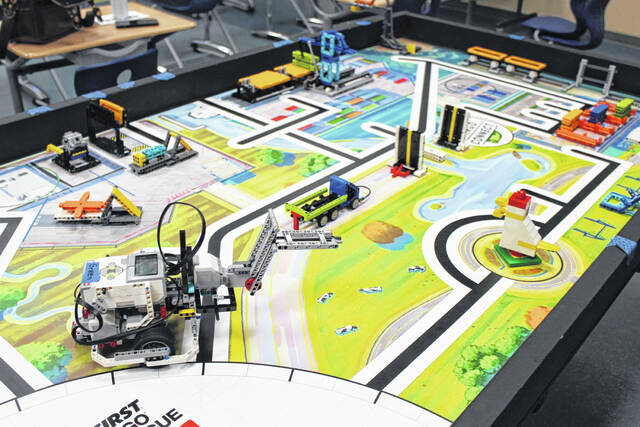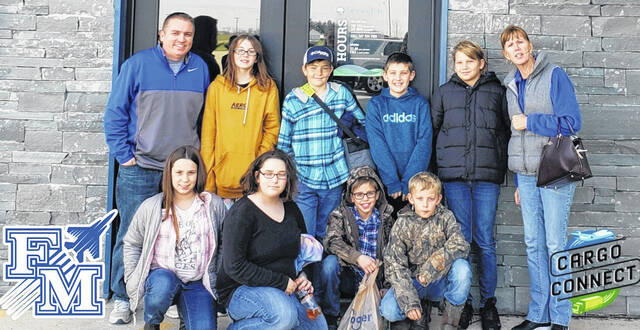
Pictured are the First Lego League mission board for 2022 as well as the Franklin Monroe-Bots’ uniquely-designed robot.
Dawn Hatfield | The Daily Advocate

The Franklin Monroe-Bots team is pictured following their demonstration to the Board of Education on Monday, Feb. 14.
Dawn Hatfield | The Daily Advocate

The Franklin Monroe-Bots team is coached by Mr. Brian Happy and Dr. Lisa Wendel. The team consists of eight members from grades five and six (listed alphabetically): Kirby Austin (6th), Adissyn Bosserman (6th), Kidren Boyd (6th), Preston Cottrell (6th), Selena Downey (6th), Jake Gehron (5th), Caroline Knight (5th), and Brauner Rumble.
Courtesy of Franklin Monroe Elementary
By Dawn Hatfield
DailyAdvocate.com
PITSBURG — Saturday, Feb. 19 will mark the second straight year Franklin Monroe Elementary’s First Lego League team, the Franklin Monroe-Bots, will compete at the state level. This year’s competition will be held remotely, so teammates will gather at the school to produce recordings of their best two minute and 30 second runs to submit for state competition.
The Franklin Monroe-Bots team consists entirely of rookies this year, making their success that much more incredible. Under the coaching of Brian Happy and Lisa Wendel, the team has worked hard on this year’s “Cargo Connect” theme. Not only must students build and program a Lego robot to complete a series of missions, but the competition also requires research and problem-solving to identify and solve a real-world problem.
Franklin Monroe-Bots’ research and innovation project idea came from a student’s father having had past experience with stubborn cows. When the father explained cows that would not cooperate during transport were often motivated by use of a Hot Shot, the students’ interests were piqued. In researching cattle prods, the team discovered their use is analogous to that of a stun gun and produces stress, immune system decreases, and loss of overall productivity.
After taking a field trip to a nearby dairy cattle farm to experience first-hand the challenges of working with large livestock, the team got to work designing a more animal-friendly stock trailer, one that would decrease the need for a cattle prod as well as lower stress on the animal. Their solution — to design a rotating trailer — would allow cattle to enter and exit the trailer without the need to back up or turn around, thereby increasing their cooperation and eliminating the need for cattle prod use.
Happy detailed the team’s performance in the two-pronged First Lego League annual event, “In a points perspective, in the Lakota Region, we finished 12th out of 30 or so teams on the [Lego mission] board; put that together with our innovative project — we finished eighth overall to qualify.”
Turning to the second phase of the competition, the Lego mission board, Preston Cottrell, grade six, described the coding blocks used to make the robot move and identified ports on their robot that correlate to the specific coding instructions.
Cottrell said, “This year’s Lego League is about getting things from point A to point B quicker.” He explained how activating a bridge and transporting items across the board all earn points in competition.
Happy added, “They only have two minutes and thirty seconds to accomplish as many [missions] as possible. There have been a lot of missions they’ve worked on and realized either accuracy or timing problems. So, they have to pick and choose.” Two team members are allowed to be at the board at a given time.
“Our best three recorded runs, we send to them, and they pick the best one and judge it,” said Cottrell.
Happy explained, “Every school has this [same mission board] layout, and they came up with their own robot themselves. In the normal in-person competition, you’d have two teams [competing], side by side, two minutes and thirty seconds, no redos, no retakes, so the pressure is really on. Hopefully next year we’re back to in-person because it really does add a nice touch to the competition part.”
Elaborating on the trial-and-error aspect of such projects, Happy said, “That’s probably the neatest thing about this — bringing in some of our brightest students here and then seeing how they attack failure. A lot of them aren’t used to that. They’re bright in classrooms and things come naturally; then, all of a sudden, we’re doing something where things didn’t go as we expected it to… they get frustrated. It’s neat to see how they take that on.”
Dawn Hatfield covers education stories for The Daily Advocate. Have a school-related event to share? Reach out by email at [email protected] or by phone at 937-569-0066.

